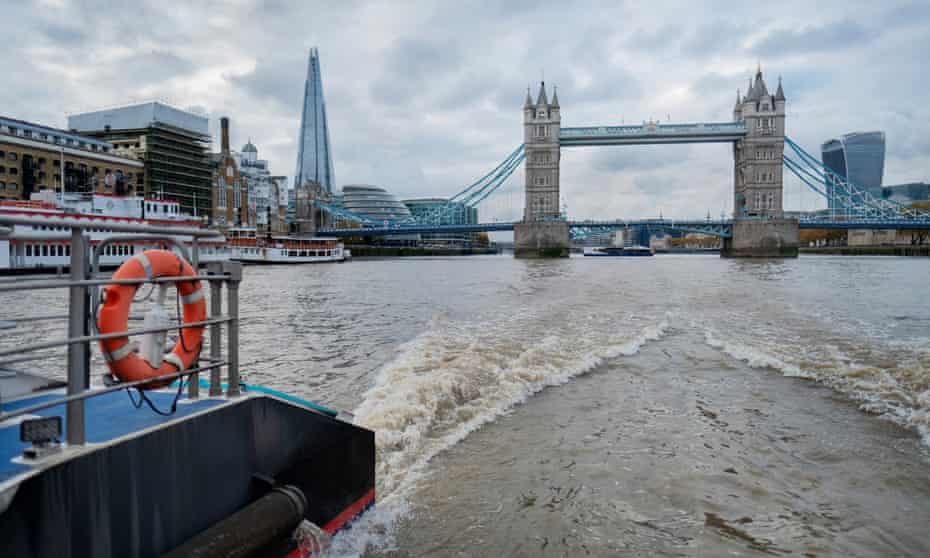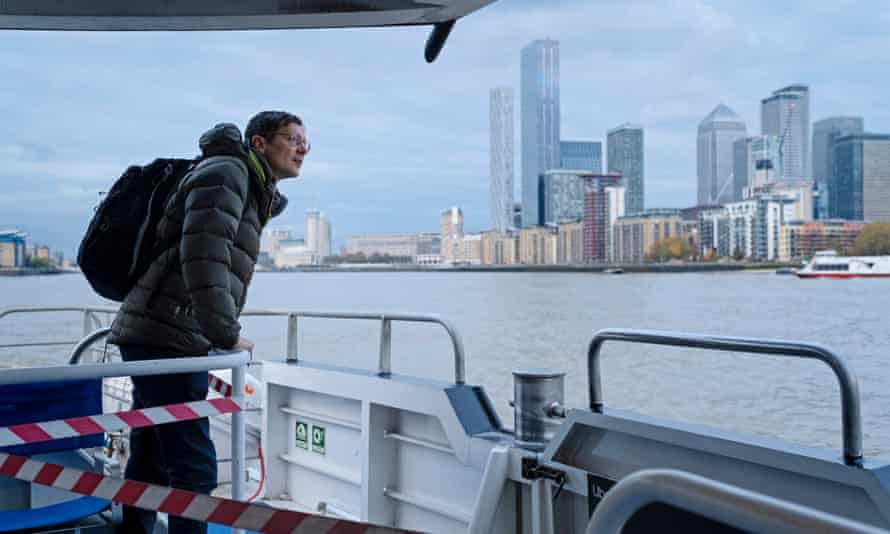‘No sharks but I’ve seen porpoises’: the rebirth of the River Thames
A trip down London’s famous waterway reveals many signs of life – but is this another false dawn?

The Thames shark hunt begins on a swirling golden brown river, where high above Battersea power station soars a speck that may be another awesome predator: a peregrine falcon.
“I haven’t seen a shark but I’ve seen porpoises up the Thames and there were a couple of whales last year,” says Alfie Gardner, captain of one of the Thames Clipper Uber Boats that whisk commuters and tourists up and downriver. “We see a lot of seals. Near enough every day.”
The 95 miles of the tidal Thames that snakes through Europe’s biggest city is full of life, according to a new survey by the Zoological Society of London (ZSL). Harbour and grey seals pop up for a reason: the Thames is home to more than 115 species of fish, and is a nursery for smelt, seabass and sharks – starry smooth-hound, tope and spurdog.
Other remarkable sightings include a juvenile short-snouted seahorse at Greenwich and a juvenile minke whale, which was stranded near Teddington this spring.
An informal shark safari via the scheduled riverboat service from the London Eye to North Greenwich starts with a promising display of common gulls, which perch on construction barges facing into the wind so their feathers won’t ruffle.
The Thames does not look alluring and its brown waters are coloured by sediment animated by the tides. Who can tell what lies beneath?
The party of visitors to the Tate Modern’s beach could probably say, if only we could understand them: this biodiversity hotspot contains two swans, four greylag geese and a gaggle of feral pigeons and gulls.

As the riverboat cruises past the Tower of London, a cormorant hangs its wings out to dry like an enormous gothic bat. This fish-eating bird is another sign that there is food in the river.
Beside the Old Thameside Inn there rolls a log: here is the Thames reborn as a Canadian mountain stream. Unfortunately, the rebirth of the Thames has met with several false dawns, and this may be another.
Before 1800, 3,000 Atlantic salmon caught on the river would be taken to Billingsgate market each year. Then the Industrial Revolution poured everything from cyanide to sewage into the river, and Victorian engineer Joseph Bazalgette’s sewage system only shifted the pollution downstream to Beckton.
In 1957, a survey conducted by the Natural History Museum made an incredible discovery: there were no fish left in the Thames. As the Guardian reported in 1959: “The tidal reaches of the Thames constitute a badly managed open sewer.”

Sewage discharged at Beckton began to be treated in 1964, industrial pollution was controlled, and heavy industry retreated from the riverside. In 1974, the first salmon was caught on the Thames – in a power station intake 16 miles below Tower Bridge – since 1833. But a 32-year effort to restore salmon by restocking the Thames with young fish ended in failure in 2011.
This week, ZSL’s survey found that the number of fish species in the tidal Thames has actually declined since the early 1990s.
“It was a surprising decline,” says Alison Debney, ZSL’s conservation programme lead for wetland ecosystem recovery. ‘I’ve been spending the last 10 years telling everybody we’ve got all these fish and isn’t that great?”
Scientists need to unpick the reasons for this decline, says Debney, which could be pollution combined with the climate crisis.
There are positive increases in dissolved oxygen concentrations and less damagingly high phosphorus levels in the Thames but harmful nitrate concentrations continue to increase, and microplastics flow down the river at a rate of up to 94,000 pieces a second.
Fish could be struggling with dramatic temperature changes: on average, summer temperatures in the upper tidal Thames have risen by 0.19C a year this century. According to Debney, this rise could be assisted by that old foe: treated sewage, which warms the river.
Raw sewage also continues to be discharged into the Thames. More than 95% of these overflows should be captured by the Thames Tideway tunnel, a GBP3.9bn super-sewer due for completion in 2025.
There’s no sign of a shark but river regulars say seals are more visible than ever. They like the Salt Quay pub in Rotherhithe – or at least the sand in front of it – and the shallows of Wandsworth. “As the river gets narrower, the seals seem to get bigger,” says Gardner.
They are keeping their heads down on this particular river cruise. Finally, a creamy shape materialises in the water beside Deptford Creek. A seal? No, it’s an old football.
The Guardian’s informal Thames safari species list
Common gull: 550
Herring gull: 22
Mute swan: 13
Greylag geese: 4
Cormorant: 1
Black-headed gull: 1
Jackdaw: 2
Floating pieces of wood: 5
Plastic bottles: 1
Tennis balls: 1
Footballs: 1